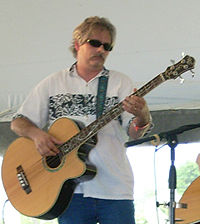User:David E. Volk: Difference between revisions
imported>David E. Volk m (→My user plan: remove) |
imported>David E. Volk |
||
| Line 280: | Line 280: | ||
== Education & Background == | == Education & Background == | ||
David E. Volk holds a bachelors degree in mathematics and physics from Minot State (ND) University, and a Ph.D (1995) in physical organic chemistry from North Dakota State University. He completed a post-doctoral fellowship at Duke University Medical Center under Leonard Spicer, was a research scientist at the University of Texas Medical Branch for 12 years, and is currently | David E. Volk holds a bachelors degree in mathematics and physics from Minot State (ND) University, and a Ph.D (1995) in physical organic chemistry from North Dakota State University. He completed a post-doctoral fellowship at Duke University Medical Center under Leonard Spicer, was a research scientist at the University of Texas Medical Branch for 12 years, and is currently an Assistant Professor at the University of Texas Health Science Center-Houston. Currently his work focuses on studying the solution structures of DNA and proteins that are important to human health or diseases using nuclear magnetic resonance (NMR) spectroscopy. | ||
These studies involve the West Nile, Yellow Fever, Omsk Hemorhaggic Fever and Dengue fever viruses. Other studies involved both structure and quantum mechanics studies of damaged DNA, such as oxidized DNA or adducted DNA. Most recently, he has initiated many metabonomics studies at UTMB. He joined the University of Texas Health Science Center-Houston in January 2009. Visit his [http://publicationslist.org/devolk publication list] list for more information and links to his publications. | These studies involve the West Nile, Yellow Fever, Omsk Hemorhaggic Fever and Dengue fever viruses. Other studies involved both structure and quantum mechanics studies of damaged DNA, such as oxidized DNA or adducted DNA. Most recently, he has initiated many metabonomics studies at UTMB. He joined the University of Texas Health Science Center-Houston in January 2009. Visit his [http://publicationslist.org/devolk publication list] list for more information and links to his publications. | ||
Revision as of 09:52, 21 January 2011

![]() Where David lives it is approximately: 12:58
Where David lives it is approximately: 12:58
All truth passes through three stages:
- First, it is ridiculed.
- Second, it is violently opposed.
- Third, it is accepted as being self-evident
- Arthur Schopenhauer (1788-1860)
Useful links
Chemistry / Health Sciences Articles I Started -part 1
Chemistry / Health Sciences Articles I Started -part 2
Music Articles I Created
- Band of Heathens
- Cover band
- Eliza Gilkyson
- Gurf Morlix
- Lightnin' Hopkins
- Liz and Lincoln
- Lucinda Williams
- Rex Bell
- Rex Bell/Discography
- REO Speedwagon
- REO Speedwagon/Discography
- Rush
- Singer-songwriter
- Hayes Carll
- Scott Nolan
- Stingaree Music Festival cluster
- Townes Van Zandt
- Townes Van Zandt/Discography (this was work!)
Other Articles I Created
- Carne gasada - a savory Mexican stew
- Chateau de Mores
- Chili-mac (vegetarian)
- Enchilada sauce - both red and green
- Galveston County Daily News
- Kim Komando
- Kirchhoff's current law
- Kirchhoff's voltage law
- Law of cosines
- Law of sines
- Judge Susan Criss of Galveston, County, Texas
- Texas Hold 'Em
Areas of Expertise
- Nuclear Magnetic Resonance (NMR) spectroscopy
- Protein NMR Structures
- West Nile virus ED3
- Omsk Hemorhagic fever ED3
- Dengue 4 virus
- Yellow fever virus
- DNA Structures
- Benzo[a]pyrene-adducted (carcinogenic) DNA
- Oxidatively Damaged DNA
- Thioaptamer DNA
- Metabonomics/Metabolomics
- Protein NMR Structures
- Quantum Mechanics
- DNA:DNA Interactions
- DNA:Metal Interactions
- Lewis Acid Chemistry
- AlCl3 and Et2AlCl mediated ring opening reactions
- SnCl4 mediated ring opening reactions
- Protein Expression & Purification
- Molecular Mechanics
Areas of General Competence
- Physical/Organic Chemistry
- Molecular Biology
- Structural Biology
- Physics
- Mathematics
- Computer Programming
- Pascal
- Perl
- C++
- MAcromolecular Purification Methods
- Surface Plasmon Resonance (Biacore)
- Binding thermodynamics and kinetics
Hobbies
- Bass Guitar
- Texas Holdem'
- Bird Watching
Education & Background
David E. Volk holds a bachelors degree in mathematics and physics from Minot State (ND) University, and a Ph.D (1995) in physical organic chemistry from North Dakota State University. He completed a post-doctoral fellowship at Duke University Medical Center under Leonard Spicer, was a research scientist at the University of Texas Medical Branch for 12 years, and is currently an Assistant Professor at the University of Texas Health Science Center-Houston. Currently his work focuses on studying the solution structures of DNA and proteins that are important to human health or diseases using nuclear magnetic resonance (NMR) spectroscopy. These studies involve the West Nile, Yellow Fever, Omsk Hemorhaggic Fever and Dengue fever viruses. Other studies involved both structure and quantum mechanics studies of damaged DNA, such as oxidized DNA or adducted DNA. Most recently, he has initiated many metabonomics studies at UTMB. He joined the University of Texas Health Science Center-Houston in January 2009. Visit his publication list list for more information and links to his publications.